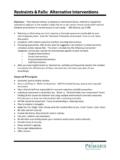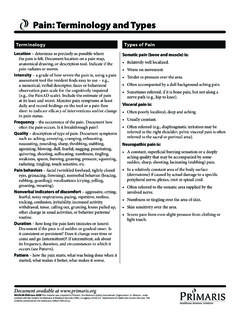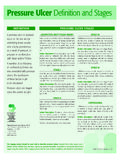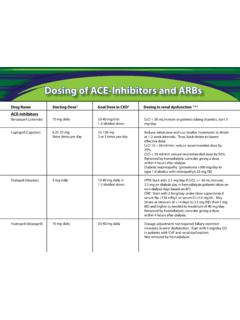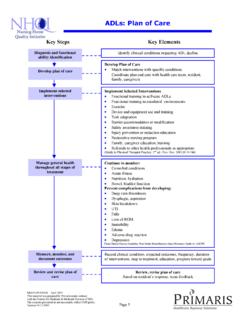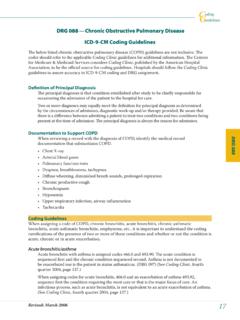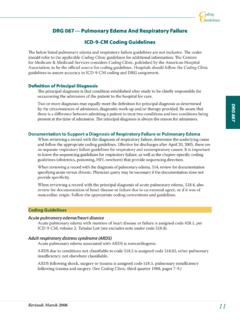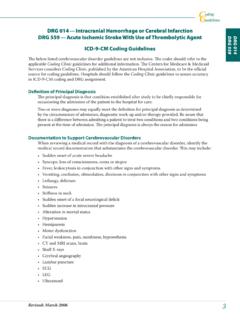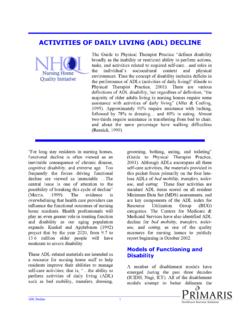Transcription of Falls: Morse Fall Scale - Primaris
1 Resident name: _____Room #:_____Medical record #: _____Date of assessment: _____Assessment #:_____The Morse fall Scale (MFS) is a rapid and simple method of assessing a resident s likelihood of falling. The MFS is used widely in acute care 1 of 2 See scoring details on page 2 Falls: Morse fall ScaleVariablesScoreHistory of fallingooNo (score as 0) ..Yes (score as 25) .._____Secondary diagnosisooNo (score as 0) ..Yes (score as 15) .._____Ambulatory aidoooBed rest/nurse assist (score as 0) ..Crutches/cane/walker (score as 15) ..Furniture (score as 30) .._____IV or IV accessooNo (score as 0) ..Yes (score as 20) .._____GaitoooNormal/bed rest/immobile (score as 0) ..Weak (score as 10) ..Impaired (score as 20) .._____Mental statusooKnows own limits (score as 0) ..Overestimates or forgets limits (score as 15).
2 _____Total ScoreRisk LevelMFS ScoreActionNo risk0 - 24 Good basic nursing careLow to moderate risk25 - 45 Implement standard fall prevention interventions using the Falling Leaf ProgramHigh risk46 +Implement high-risk fall prevention interventions using the Falling Leaf ProgramFalls: Morse fall Scalepage 2 of 2 Document available at April 2006 This material was prepared by Primaris , the Medicare Quality Improvement Organization for Missouri, under contract with the Centers for Medicare & Medicaid Services (CMS), an agency of the Department of Health and Human Services. The contents presented do not necessarily reflect CMS items on the Scale are scored as follows. The score is then tallied and recorded on the resident s assessment/chart. Risk level and recommended actions are identified.
3 History of FallingNote: If a resident falls for the first time, then his/her score immediately increases by 25. 25 Identify all current residents at risk for falls at the beginning of the program using the facility risk assessment form or a chosen form . This could be done by the charge nurse, supervising registered nurse, or interdisciplinary care team . Residents with highest risk or residents having multiple falls may be placed in Falling Leaf precaution . 0 The resident has not fallen, this is scored 0 . Secondary Diagnosis 15 More than one medical diagnosis is listed on the resident s chart . 0 No more than one medical diagnosis is listed on the resident s chart . Ambulatory Aids30 The resident ambulates clutching onto the furniture for support .15 The resident uses crutches, a cane, or a walker.
4 0 The resident walks without a walking aid (even if assisted by a nurse), uses a wheelchair, or is on bed rest and does not get out of bed at all . Intravenous Therapy20 The resident has an intravenous apparatus or heparin lock inserted . 0 The resident does not have an intravenous apparatus or a heparin lock inserted .Gait20 The resident has an impaired gait . With an impaired gait, the resident may have difficulty rising from the chair or attempts to get up by pushing on the arms of the chair or by bouncing . The resident s head is down, and he/she watches the ground . Because the residents balance is poor, the resident grasps onto the furniture, a support person or a walking aid for support and cannot walk without assistance .10 The resident has a weak gait . With a weak gait, he/she is stooped but able to lift the head while walking without losing balance.
5 Steps are short and the resident may shuffle . 0 This resident has a normal gait . A normal gait is characterized by the resident walking with the head erect, arms swinging freely at the side, and striding without hesitation . Mental StatusWhen using this Scale , mental status is measured by checking the residents self-assessment of his/her own ability to ambulate. Ask the resident, Are you able to go to the bathroom alone, or do you need assistance? 15 The resident s response is not consistent with nursing orders . If the resident s response is unrealistic, then he/she is considered to overestimate his/her own abilities and to be forgetful of limitations . 0 The resident s reply judging his/her own ability is consistent with the ambulatory order on the plan of care . The resident is rated as normal.
6
